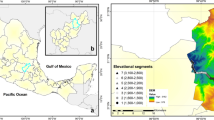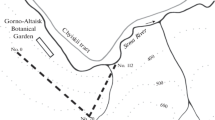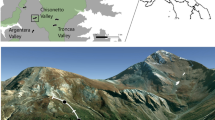Abstract
Mountain regions harbour dynamic ecosystems that have been historically shaped by interactions between natural abiotic processes and human activities, but nowadays they are threatened by climate change. Avalanches are one of the main sources of natural disturbance in mountain areas, creating habitat mosaics with a high vegetation heterogeneity that can be exploited by a suite of animal species. Since snow precipitation regimes in mountain regions will be altered by climate change, it is fundamental to study the interactions between avalanches and biodiversity. We carried out surveys on 240 points across horizontal and vertical transects in the Western Italian Alps to assess the differences in habitat, bird assemblage composition and ecological traits between avalanche tracks and control points. Differences in both habitat and bird assemblages were more pronounced at lower elevations and became less obvious towards alpine grasslands. Avalanche tracks were characterised by a higher structural vegetation diversity with a greater cover of rocks, shrubs and a higher number of small trees. Bird assemblages differed between avalanche tracks and adjacent control points, with the former being more diverse and characterised by a higher proportion of species typical of open habitats and migrants. Importantly, the avalanche track bird assemblage differed from both forest and treeline ecotone assemblages, showing that these heterogeneous areas are unique, harbouring a mixture of bird species from different habitats. Avalanche frequency may be affected by climate change in the future, with consequences for mountain biodiversity at a broader scale, and hence should be a priority for alpine ecological research.
Zusammenfassung
Lawinenabgänge in den europäischen Alpen schaffen einzigartige Lebensräume für Vögel.
Gebirgsregionen beherbergen dynamische Ökosysteme, die historisch durch die Wechselwirkungen zwischen natürlichen abiotischen Prozessen und menschlichen Aktivitäten geprägt wurden, heute aber vom Klimawandel bedroht sind. Lawinenabgänge sind eine der Hauptursachen für natürliche Beeinträchtigungen in Gebirgsregionen und schaffen Lebensraummosaike mit einer hohen Pflanzenvielfalt, die von einer Reihe von Tierarten genutzt werden können. Da sich die Schneefallverhältnisse in den Gebirgsregionen durch den Klimawandel verändern werden, ist es von grundlegender Bedeutung, die Wechselwirkungen zwischen Lawinen und Artenvielfalt zu untersuchen. In den westlichen italienischen Alpen machten wir an 240 Messpunkten entlang von horizontalen und vertikalen Streifen Untersuchungen, um Unterschiede in den Lebensräumen, der Zusammensetzung der Vogelgemeinschaften und den ökologischen Merkmalen zwischen den Bahnen der Lawinenabgänge und den Kontrollpunkten zu ermitteln. Die Unterschiede sowohl bei den Lebensräumen als auch den Vogelgemeinschaften waren in niedrigeren Lagen stärker ausgeprägt und wurden in Richtung der alpinen Bergwiesen weniger deutlich. Die Bahnen der Lawinenabgänge zeichneten sich durch eine höhere Artenvielfalt der Vegetation und stärkerer Bedeckung der Felsen und Sträucher und durch eine höhere Anzahl kleiner Bäume aus. Die Zusammensetzung der Vogelgemeinschaften war auf den Lawinenbahnen und angrenzenden Kontrollpunkten unterschiedlich, wobei erstere vielfältiger waren und einen höheren Anteil an für offene Lebensräume und Zugvögel typische Arten aufwiesen. Wichtig ist, dass sich die Vogelgemeinschaften der Lawinenschneisen sowohl von denen des Waldes als auch von denen der Baumgrenze unterscheiden, was zeigt, dass diese heterogenen Areale einzigartig sind und eine Mischung von Vogelarten aus verschiedenen Lebensräumen beherbergen. Die Häufigkeit von Lawinenabgängen könnte in Zukunft durch den Klimawandel beeinflusst werden, was sich auf breiter Ebene auf die biologische Vielfalt in den Bergen auswirken könnte und daher eine der Hauptaufgaben der alpinen ökologischen Forschung sein sollte.



Similar content being viewed by others
Data availability
The datasets used and/or analysed during the current study are available from the corresponding author on reasonable request.
References
Alba R, Kasoar T, Chamberlain D, Buchanan G, Thompson D, Pearce-Higgins JW (2022) Drivers of change in mountain and upland bird populations in Europe. Ibis. https://doi.org/10.1111/ibi.13043
Alldredge MW, Pollock KH, Simons TR, Collazo JA, Shriner SA (2007) Time-of-detection method for estimating abundance from point-count surveys. Auk 124:653
Anderson MJ (2006) Distance-based tests for homogeneity of multivariate dispersions. Biometrics 62:245–253
Archaux F (2007) Are mountains refuges for farmland bird species? A case study in the northern French Alps. Bird Study 54:73–79
Arpa Piemonte (2020) Sistema Informativo Valanghe – SIVa. Available at http://webgis.arpa.piemonte.it/. Accessed on 09.03.2020
Assandri G, Bogliani G, Pedrini P, Brambilla M (2019a) Species-specific responses to habitat and livestock management call for carefully targeted conservation strategies for declining meadow birds. J Nat Conserv 52:125757
Assandri G, Bogliani G, Pedrini P, Brambilla M (2019b) Toward the next Common Agricultural Policy reform: determinants of avian communities in hay meadows reveal current policy’s inadequacy for biodiversity conservation in grassland ecosystems. J Appl Ecol 56:604–617
Bairlein F (2016) Migratory birds under threat. Science 354:547–548
Ballesteros-Cánovas JA, Trappmann D, Madrigal-González J, Eckert N, Stoffel M (2018) Climate warming enhances snow avalanche risk in the Western Himalayas. Proc Natl Acad Sci USA 115:3410–3415
Bani L, Luppi M, Rocchia E, Dondina O, Orioli V (2019) Winners and losers: How the elevational range of breeding birds on Alps has varied over the past four decades due to climate and habitat changes. Ecol Evol 9:1289–1305
Bazzi G, Foglini C, Brambilla M, Saino N, Rubolini D (2015) Habitat management effects on Prealpine grassland bird communities. Ital J Zool 82:251–261
Bebi P, Kienast F, Schönenberger W (2001) Assessing structures in mountain forests as a basis for investigating the forests’ dynamics and protective function. For Ecol Manag 145:3–14
Bebi P, Kulakowski D, Rixen C (2009) Snow avalanche disturbances in forest ecosystems-State of research and implications for management. For Ecol Manag 257:1883–1892
Bebi P, Seidl R, Motta R, Fuhr M, Firm D, Krumm F, Conedera M, Ginzler C, Wohlgemuth T, Kulakowski D (2017) Changes of forest cover and disturbance regimes in the mountain forests of the Alps. For Ecol Manag 388:43–56
Bell PC (2000) Process in the evolution of bird migration and pattern in avian ecogeography. J Avian Biol 31:258–265
Bellard C, Bertelsmeier C, Leadley P, Thuiller W, Courchamp F (2012) Impacts of climate change on the future of biodiversity. Ecol Lett 15:365–377
Bibby CJ, Burgess ND, Hillis DM, Hill DA, Mustoe S (2000) Bird census techniques. Elsevier
Bilcke G (1984) Residence and non-residence in passerines: dependence on the vegetation structure. Ardea 72:223–227
Bischof N (1984) Pflanzensoziologische Untersuchungen von Sukzessionen aus gemähten Magerrasen in der subalpinen Stufe der Zentralalpen vol 60 Beiträge zur geobotanischen Landesaufnahme der Schweiz Flück-Wirth, Switzerland
Bormann KJ, Brown RD, Derksen C, Painter TH (2018) Estimating snow-cover trends from space. Nat Clim Change 8:924–928
Brang P, Schönenberger W, Frehner M, Schwitter R, Thormann JJ, Wasser B (2006) Management of protection forests in the European Alps: an overview. For Snow Landsc Res 80:23–44
Castebrunet H, Eckert N, Giraud G, Durand Y, Morin S (2014) Projected changes of snow conditions and avalanche activity in a warming climate: the French Alps over the 2020–2050 and 2070–2100 periods. Cryosphere 8:1673–1697
Chamberlain D, Negro M, Caprio E, Rolando A (2013) Assessing the sensitivity of alpine birds to potential future changes in habitat and climate to inform management strategies. Biol Conserv 167:127–135
Davey CM, Chamberlain D, Newson SE, Noble DG, Johnston A (2012) Rise of the generalists: evidence for climate driven homogenization in avian communities. Glob Ecol Biogeogr 21:568–578
De Cáceres M, Legendre P (2009) Associations between species and groups of sites: indices and statistical inference. Ecology 90:3566–3574
De Cáceres M, Jansen F (2015) Package ‘indicspecies’ (Version 176). https://cran.r-project.org/web/packages/indicspecies/indicspecies.pdf
De Cáceres M, Legendre P, Moretti M (2010) Improving indicator species analysis by combining groups of sites. Oikos 119:1674–1684
Diefenbach DR, Marshall MR, Mattice JA, Brauning DW (2007) Incorporating availability for detection in estimates of bird abundance. Auk 124:96–106
Dullinger S, Dirnböck T, Grabherr G (2003) Patterns of Shrub Invasion into High Mountain Grasslands of the Northern Calcareous Alps, Austria Arctic, Antarct. Alp Res 35:434–441
Eckert N, Parent E, Kies R, Baya H, Eckert N, Parent E, Morse E (2010) A spatio-temporal modelling framework for assessing the fluctuations of avalanche occurrence resulting from climate change: application to 60 years of data in the northern French Alps. Clim Change 101:515–553
Gądek B, Kaczka RJ, Rączkowska Z, Rojan E, Casteller A, Bebi P (2017) Snow avalanche activity in Żleb Żandarmerii in a time of climate change (Tatra Mts, Poland). CATENA 158:201–212
Garcia-Gonzalez R, Cuartas P (1996) Trophic utilization of a montane/subalpine forest by chamois (Rupicapra pyrenaica) in the Central Pyrenees. For Ecol Manage 88:15–23
Gehrig-Fasel J, Guisan A, Zimmermann NE (2007) Tree line shifts in the Swiss Alps: climate change or land abandonment? J Veg Sci 18:571–582
Gellrich M, Bauer P, Zimmermann NE, Koch B (2007) Agricultural land abandonment and natural forest re-growth in the Swiss mountains: a spatially explicit economic analysis. Agric Ecosyst Environ 118:93–108
Getzner M, Gutheil-Knopp-Kirchwald G, Kreimer E, Kirchmeir H, Huber M (2017) Gravitational natural hazards: valuing the protective function of Alpine forests. For Policy Econ 80:150–159
Gobiet A, Kotlarski S (2020) Future climate change in the European Alps. Oxford Res Encycl Clim Sci. https://doi.org/10.1093/acrefore/9780190228620.013.767
Gobiet A, Kotlarski S, Beniston M, Heinrich G, Rajczak J, Stoffel M (2014) 21st century climate change in the European Alps—a review. Sci Tot Environ 493:1138–1151
Höller P (2007) Avalanche hazards and mitigation in Austria: a review. Nat Haz 43:81–101
Ingty T (2021) Pastoralism in the highest peaks: Role of the traditional grazing systems in maintaining biodiversity and ecosystem function in the alpine Himalaya. PLoS ONE 16:e0245221
IPCC (2022) Climate change 2022: impacts, adaptation, and vulnerability. In: Pörtner H-O, Roberts DC, Tignor M, Poloczanska ES, Mintenbeck K, Alegría A, Craig M, Langsdorf S, Löschke S, Möller V, Okem A, Rama B (eds) Contribution of working group II to the sixth assessment report of the intergovernmental panel on climate change. Cambridge University Press
Jähnig S, Alba R, Vallino C, Rosselli D, Pittarello M, Rolando A, Chamberlain D (2018) The contribution of broadscale and finescale habitat structure to the distribution and diversity of birds in an Alpine forest-shrub ecotone. J Ornithol 159:747–759
Johansson MU, Frisk CA, Nemomissa S, Hylander K (2018) Disturbance from traditional fire management in subalpine heathlands increases Afro-alpine plant resilience to climate change. Glob Chang Biol 24:2952–2964
Kassambara A, Mundt F (2017) Factoextra: extract and visualize the results of multivariate data analyses. R Package Vers 1(5):337–354
Krajick K (1998) Animals thrive in an avalanche’s wake. Science 279:1853
Kulakowski D, Rixen C, Bebi P (2006) Changes in forest structure and in the relative importance of climatic stress as a result of suppression of avalanche disturbances. For Ecol Manag 223:66–74
Kulakowski D, Seidl R, Holeksa J, Kuuluvainen T, Nagel TA, Panayotov M, Svoboda M, Thorn S, Vacchiano G, Whitlock C, Wohlgemuth T, Bebi P (2017) A walk on the wild side: Disturbance dynamics and the conservation and management of European mountain forest ecosystems. For Ecol Manag 388:120–131
Laiolo P, Dondero F, Ciliento E, Rolando A (2004) Consequences of pastoral abandonment for the structure and diversity of the alpine avifauna. J Appl Ecol 41:294–304
Laternser M, Schneebeli M (2003) Long-term snow climate trends of the Swiss Alps (1931–99). Int J Climatol 23:733–750
Laute K, Beylich AA (2018) Potential effects of climate change on future snow avalanche activity in western Norway deduced from meteorological data. Geogr Ann Ser a, Phys Geogr 100:163–184
Lieser M (1995) Lebensraumansprüche des Haselhuhns im Schwarzwald. Naturschutzreport 10:239–255
Loarie SR, Duffy PB, Hamilton H, Asner GP, Field CB, Ackerly DD (2009) The velocity of climate change. Nature 462:1052–1055
Martinez Arbiz P (2017) PairwiseAdonis: pairwise multilevel comparison using adonis. https://github.com/pmartinezarbizu/pairwiseAdonis
McClung D, Schaerer P (1993) The Avalanche handbook. The Mountaineers, Seattle
Mietkiewicz N, Kulakowski D, Rogan J, Bebi P (2017) Long-term change in sub-alpine forest cover, tree line and species composition in the Swiss Alps. J Veg Sci 28:951–964
Nogués-Bravo D, Araújo MB, Errea MP, Martínez-Rica JP (2007) Exposure of global mountain systems to climate warming during the 21st Century. Glob Environ Chang 17:420–428
Oksanen J, Blanchet FG, Kindt R, Legendre P, Minchin PR, O’Hara R, Simpson GL, Solymos P, Henry M et al (2013) Package ‘Vegan’ Community Ecology Package, Version 2. http://CRAN.R-project.org/package=vegan
Pacifici M, Visconti P, Rondinini C (2018) A framework for the identification of hotspots of climate change risk for mammals. Glob Chang Biol 24:1626–1636
Pini R, Ravazzi C, Raiteri L, Guerreschi A, Castellano L, Comolli R (2017) From pristine forests to high-altitude pastures: an ecological approach to prehistoric human impact on vegetation and landscapes in the western Italian Alps. J Ecol 105:1580–1597
QGIS Development Team (2020) QGIS geographic information system. Open Source Geospatial Foundation Project. http://qgis.osgeo.org
R Core Team (2021) R: A language and environment for statistical computing R Foundation for Statistical Computing. https://www.R-projectorg/
Requena E, Alba R, Rosselli D, Chamberlain D (2022) Avalanche tracks are key habitats for the Rock Bunting Emberiza cia in the Alps. Ardeola 69:203–217
Rixen C, Brugger S (2004) Naturgefahren-ein Motor der Biodiversität. In: Eidg Forschungsanstalt WSL (ed) Schutzwald und Naturgefahren. Forum für Wissen, Cham, pp 67–71
Rixen C, Haag S, Kulakowski D, Bebi P (2007) Natural avalanche disturbance shapes plant diversity and species composition in subalpine forest belt. J Veg Sci 18:735–742
Salinas H, Ramirez-Delgado D (2021) ecolTest: community ecology tests. R, R package
Schöner W, Koch R, Matulla C, Marty C, Tilg AM (2019) Spatiotemporal patterns of snow depth within the Swiss-Austrian Alps for the past half century (1961 to 2012) and linkages to climate change. Int J Clim 39:1589–1603
Scridel D, Brambilla M, Martin K, Lehikoinen A, Iemma A, Matteo A, Jähnig S, Caprio E, Bogliani G, Pedrini P, Rolando A, Arlettaz R, Chamberlain D (2018) A review and meta-analysis of the effects of climate change on Holarctic mountain and upland bird populations. Ibis 160:489–515
Solymos P, Moreno M, Lele SR (2013a) Detect: analyzing wildlife data with detection error R package version 03. http://CRAN.R-project.org/package=detect
Sólymos P, Matsuoka SM, Bayne EM, Lele SR, Fontaine P, Cumming SG, Stralberg D, Schmiegelow FKA, Song SJ (2013b) Calibrating indices of avian density from non-standardized survey data: making the most of a messy situation. Methods Ecol Evol 4:1047–1058
Sólymos P, Matsuoka SM, Cumming SG, Stralberg D, Fontaine P, Schmiegelow FKA, Song SJ, Bayne EM (2018) Evaluating time-removal models for estimating availability of boreal birds during point count surveys: sample size requirements and model complexity. Condor 120:765–786
Stocker E (2009) Geomorphic responses to landuse changes on steep slopes in timberline environment; Central Alps, Austria. Rom J Geogr 53:91–106
Strapazzon G, Schweizer J, Chiambretti I, Brodmann Maeder M, Brugger H, Zafren K (2021) Effects of climate change on avalanche accidents and survival. Front Physiol 12:450–460
Teich M, Marty C, Gollut C, Grêt-Regamey A, Bebi P (2012) Snow and weather conditions associated with avalanche releases in forests: rare situations with decreasing trends during the last 41years. Cold Reg Sci Technol 83–84:77–88
Thuiller W, Lavorel S, Araú Jo MB, Sykes MT, Prentice IC, Mooney HA (2005) Climate change threats to plant diversity in Europe. Natl Acad Sci 102:8245–8250
Tobias JA, Sheard C, Pigot AL et al (2022) AVONET: morphological, ecological and geographical data for all birds. Ecol Lett 25:581–597. https://doi.org/10.1111/ELE.13898
Vacchiano G, Maggioni M, Perseghin G, Motta R (2015) Effect of avalanche frequency on forest ecosystem services in a spruce–fir mountain forest. Cold Reg Sci Technol 115:9–21
Viglietti D, Letey S, Motta R, Maggioni M, Freppaz M (2010) Snow avalanche release in forest ecosystems: a case study in the Aosta Valley Region (NW-Italy). Cold Reg Sci Technol 64:167–173
Zimmerer KS, Córdova-Aguilar H, Mata Olmo R, Jiménez Olivencia Y, Vanek SJ (2017) Mountain ecology, remoteness, and the rise of agrobiodiversity: tracing the geographic spaces of human-environment knowledge. Ann Am Assoc Geogr 107:441–455
Acknowledgements
We thank the staff of Ente di Gestione delle Aree Protette delle Alpi Cozie for the support. We are also grateful to Pietro Bolognino, Margherita Penna, Andrés Carrasco and Veronica Dutto for helping with fieldwork.
Funding
This research did not receive any specific grant from funding agencies in the public, commercial, or not-for-profit sectors.
Author information
Authors and Affiliations
Contributions
RA and DC initiated the study. RA and LO collected the data. RA and DC conceptualised the manuscript. RA analysed the data with inputs from LO and DC. RA wrote the manuscript with inputs from DC.
Corresponding author
Ethics declarations
Conflict of interest
The authors declare that they have no known competing financial interests or personal relationships that could have appeared to influence the work reported in this paper.
Additional information
Communicated by T. Gottschalk.
Publisher's Note
Springer Nature remains neutral with regard to jurisdictional claims in published maps and institutional affiliations.
Supplementary Information
Below is the link to the electronic supplementary material.
Rights and permissions
Springer Nature or its licensor (e.g. a society or other partner) holds exclusive rights to this article under a publishing agreement with the author(s) or other rightsholder(s); author self-archiving of the accepted manuscript version of this article is solely governed by the terms of such publishing agreement and applicable law.
About this article
Cite this article
Alba, R., Oddi, L., Rosselli, D. et al. Avalanches create unique habitats for birds in the European Alps. J Ornithol 164, 377–388 (2023). https://doi.org/10.1007/s10336-022-02039-3
Received:
Revised:
Accepted:
Published:
Issue Date:
DOI: https://doi.org/10.1007/s10336-022-02039-3




